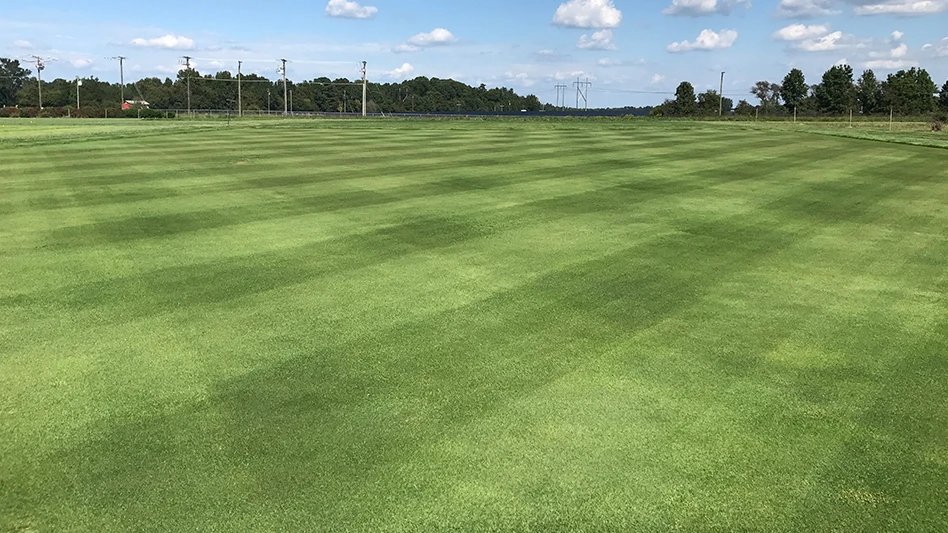


The term plant growth regulator (PGR) encompasses a wide range of active ingredients used in agriculture, turfgrass, and ornamentals. These compounds are classified based on their activity as growth promoters or growth inhibitors. In turfgrass, PGRs are typically used as growth inhibitors, with Class A and Class B PGRs being the two most common. The active ingredients in both Classes A and B suppress turfgrass growth by inhibiting gibberellic acid (GA) biosynthesis. The key difference between Class A and Class B is site of action in the GA biosynthesis pathway. Class A PGRs are active late and Class B PGRs are active early in the GA biosynthesis pathway. This results in varying amounts of turfgrass growth suppression between Class A and Class B PGRs.
There are also differences in growth suppression between turfgrass species for each PGR. Generally, cool-season turfgrass species will require higher PGR application rates than warm-season species. However, differences also exist between turfgrass species within each group. Most notably, Class B PGRs are significantly more active on annual bluegrass (Poa annua) than they are on other cool-season species. This has led to Class B PGRs being widely used to suppress weedy annual bluegrass in cool-season turf.
Applications containing both Class A and Class B PGRs have become popular due to their two-fold activity in suppressing weedy annual bluegrass, while also reducing the growth of the desired turfgrass species. It’s important to understand that there is an additive effect on turfgrass growth suppression (1+1 = 2) when combining PGR active ingredients. Application rates and intervals need to be double-checked when combining active ingredients to avoid turfgrass injury.
Understanding the differences between Classes is important when building a PGR program, but you must also consider the objectives of the program. Are you looking for turfgrass growth suppression or weedy annual bluegrass management? Maybe a combination of both? Establishing the objectives will help simplify the process of selecting the most appropriate PGR products.

Cutless® (known as: Cutless® 50W and Cutless® MEC) contains the active ingredient flurprimidol, a Class B PGR. It is most well-known for the suppression of weedy annual bluegrass, but it also provides bestin-class turfgrass color and density. In cool-season turfgrass, programs containing Cutless are typically designed in one of two ways. The first is applying Cutless in the spring and fall to give the desired turfgrass a competitive advantage over weedy annual bluegrass. During the summer, a Class A PGR such as trinexapac-ethyl or prohexadione-Ca is typically applied to suppress turfgrass growth when annual bluegrass is not as competitive.
The second program involves applying Cutless all season long in combination with a Class A PGR. This program is designed to maximize turfgrass growth suppression and weedy annual bluegrass management. The amount of weedy annual bluegrass activity is dictated by the Cutless application rate, whereas turfgrass growth suppression is dictated by the rates of both Cutless and the Class A PGR (remember: 1+1 = 2). Generally, the combination program leads to more aggressive weedy annual bluegrass management and desired turfgrass growth suppression than the spring/fall program.
In warm-season turf, Cutless is most often used in a combination program with a Class A PGR to improve growth suppression. Combining the two has been shown to lengthen suppression compared to Cutless or the Class A being applied alone. Adding Cutless to the program also results in increased turfgrass color and density compared to the Class A alone.
Legacy®, containing the Class A trinexapac-ethyl and Class B flurprimidol, has been proven as a premier turfgrass suppression product. The combination of a Class A and Class B PGR in the same formulation provides ease of use compared to tank-mixing. Legacy is well suited for season-long use in both warm- and cool- season turfgrass. The ratio of the two active ingredients is optimized for turfgrass growth suppression, but the flurprimidol also provides weedy annual bluegrass suppression. In areas with high annual bluegrass pressure, the recommended program is to apply Cutless in the spring and fall while applying Legacy during the summer.
Musketeer® is the only PGR on the market containing three active ingredients. The microemulsion formulation combines two Class Bs, flurprimidol and paclobutrazol, and the Class A trinexapac-ethyl. Musketeer contains low concentrations of each active ingredient making it safe on sensitive species such as creeping bentgrass. The best fit for Musketeer is in cool-season turf with high, weedy annual bluegrass pressure. It provides the best of both worlds in terms of managing turfgrass growth and suppressing weedy annual bluegrass. Musketeer programs have been shown to reduce weedy annual bluegrass populations by more than 70 percent over a single season.
Designing and implementing a PGR program does not have to be complicated despite the differences in PGR classes and active ingredients. The key is to set the objectives of the program before you decide on products. Cutless, Legacy, and Musketeer provide flexibility to meet your objectives, whether as a customized mix or in the ease of a single jug.

Explore the May 2023 Issue
Check out more from this issue and find your next story to read.
Latest from Golf Course Industry
- From the publisher’s pen: Conscientious of a bigger role
- Bernhard and Company partners with Laguna Golf Phuket
- Terre Blanche showcases environmental stewardship
- VIDEO: Introducing our December issue
- Bernhard and Company introduces Soil Scout
- Nu-Pipe donates to GCSAA Foundation’s Centennial Campaign
- GCSAA enhances golf course BMP tool
- Melrose leadership programs sending 18 to 2026 GCSAA Conference and Trade Show





